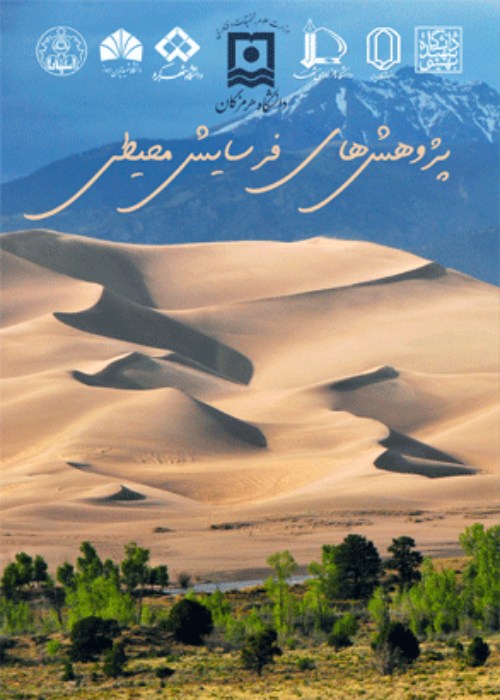Analysis of the effects of climatic elements on the mobility of wind-blown sand in the west of Lut desert
Sand dunes are one of the most important landforms in arid and semi-arid regions, whose mobility varies depending on climatic factors, especially the speed and frequency of erosive winds, rainfall, and the amount of evaporation and transpiration, which always causes many problems for the activity of these dunes. Therefore, monitoring climatic factors and analyzing dust events can be a positive step toward knowing the factors affecting their activity and predicting their mobility status in the future. Lut desert, with its huge amount of sand masses, is one of the most active places concerning changes in wind speed and direction. The eastern part of this region, which includes the largest sand mass of Iran, the Yalan sand, is dominated by the 120-day winds, which doubles the importance of investigating the winds and their shaping role during the blowing season of these winds. Based on this, the current research was conducted to analyze the mobility of quicksands in Lut plain stations in the past and predict their conditions in the future.
The study area includes the Lut desert located in Kerman province. To conduct this research, average monthly values of climatic elements including temperature, rainfall, hourly data related to horizontal field of view, wind speed and direction, and the code of various dust phenomena were used. These data were received from the Meteorological Organization of seven synoptic stations that have statistics for 20 years (2002 to 2021). Investigating the changes of climatic parameters over 20 years, investigating the temporal and spatial mechanism pattern of dust, wind and storm rose, calculating the amount of evaporation and transpiration using the Torrent-White method, investigating the condition of dunes using the Lancaster index were the main steps of the current research. The mobility of quicksands was texted using a sensitivity analysis and at the end, the zoning maps of the final sand transport potential were prepared using ArcGIS software.
The results showed that the stations leading to Lut plain are facing a decrease in rainfall and an increase in temperature, evaporation, and transpiration. The changes in wind speed are high in Shahdad station and low in Baft station, and the prevailing wind direction in most of the studied stations is west and north. The highest frequency of local and extra-local winds is related to Nehbandan station with 1090 days and Bam station with 791 days, and the lowest frequency of winds is Local and extra-local corresponding to Baft station with 23 and 31 days, respectively. The calculation of the aridity index of the stations showed that the index of prevailing climatic conditions in the region is dry, ultra-arid, and semi-arid due to the activeness of wind deposits and the peak time of local events in the stations located in plain areas, and this means Shahdad station has become a real desert in terms of desertification risk, Baft station is under severe desertification risk, and other five stations are under very severe desertification risk. With the reduction of the UNEP aridity index and the increase of the aridity of the environment, the amount of sand mobility in the whole Lut plain is increased and the risk of desertification in the region is intensified. Based on the sensitivity analysis, if in the future the frequency of winds exceeds the erosion threshold by 30%, the activity and movement of dunes will increase by 30%, while with a 30% increase in rainfall, the dune activity will decrease by 43%. Also, the sand mobility index has a positive relationship with changes in evaporation and transpiration. With a 30 % increase in evaporation and transpiration and the speed of erosive winds, the activity and movement of dunes increase by up to 70 %, and with a 30 % decrease in these two meteorological indicators, the activity and movement of dunes decrease by 50 %.
By calculating the Lancaster index, the potential activity of dunes has been determined and the active and inactive areas have been separated. The results of the zoning of this index showed that in the studied area, the activity level of dunes is mostly completely active and active at the top of the dunes. It is inactive only in Bam station, which has been done to stabilize and reduce dust activity and management measures such as planting trees, hand-planting desert forests, dunes, and mulching. However, due to the activity of the dunes in other stations, these measures are not enough and need new management and planning. The results of the present research can be used to predict the future condition of dunes and determine appropriate management measures to control and reduce possible damage to other land uses in the region.
- حق عضویت دریافتی صرف حمایت از نشریات عضو و نگهداری، تکمیل و توسعه مگیران میشود.
- پرداخت حق اشتراک و دانلود مقالات اجازه بازنشر آن در سایر رسانههای چاپی و دیجیتال را به کاربر نمیدهد.


